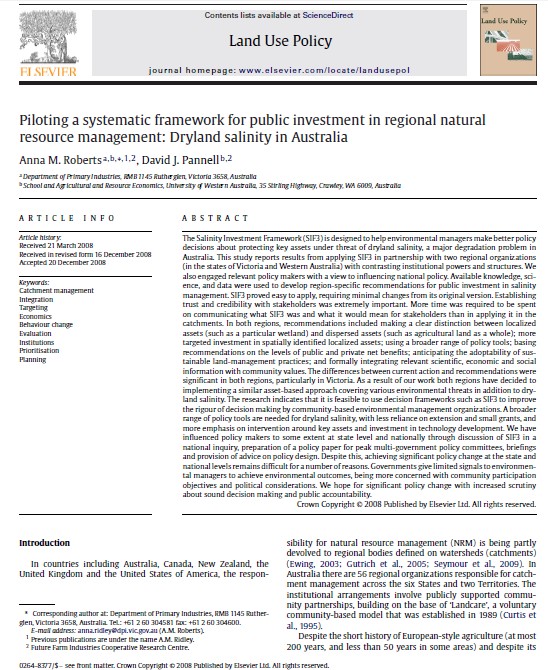Piloting a systematic framework
This is an article that outlines our experience in working with regional environmental management bodies to implement SIF3, the precursor to INFFER. The lessons learnt here had a big influence on the design of INFFER. The citation is:
Roberts, A. and Pannell, D. (2009) Piloting a systematic framework for public investment in regional natural resource management: dryland salinity in Australia, Land Use Policy 26(4): 1001-1010.
Abstract
The Salinity Investment Framework (SIF3) is designed to help environmental managers make better policy decisions about protecting key assets under threat of dryland salinity, a major degradation problem in Australia. This study reports results from applying SIF3 in partnership with two regional organisations (in the states of Victoria and Western Australia) with contrasting institutional powers and structures. We also engaged relevant policy makers with a view to influencing national policy. Available knowledge, science, and data were used to develop region-specific recommendations for public investment in salinity management. SIF3 proved easy to apply, requiring minimal changes from its original version. Establishing trust and credibility with stakeholders was extremely important. More time was required to be spent on communicating what SIF3 was and what it would mean for stakeholders than in applying it in the catchments. In both regions, recommendations included making a clear distinction between localised assets (such as a particular wetland) and dispersed assets (such as agricultural land as a whole); more targeted investment in spatially identified localised assets; using a broader range of policy tools; basing recommendations on the levels of public and private net benefits; anticipating the adoptability of sustainable land-management practices; and formally integrating relevant scientific, economic and social information with community values. The differences between current action and recommendations were significant in both regions, particularly in Victoria. As a result of our work both regions have decided to implementing a similar asset-based approach covering various environmental threats in addition to dryland salinity. The research indicates that it is feasible to use decision frameworks such as SIF3 to improve the rigour of decision making by community-based environmental management organisations. A broader range of policy tools are needed for dryland salinity, with less reliance on extension and small grants, and more emphasis on intervention around key assets and investment in technology development. We have influenced policy makers to some extent at state level and nationally through discussion of SIF3 in a national inquiry, preparation of a policy paper for peak multi-government policy committees, briefings and provision of advice on policy design. Despite this, achieving significant policy change at the state and national levels remains difficult for a number of reasons. Governments give limited signals to environmental managers to achieve environmental outcomes, being more concerned with community participation objectives and political considerations. We hope for significant policy change with increased scrutiny about sound decision making and public accountability.
Pre-publication version of the full paper (270K)
For a copy of the article, email us.


